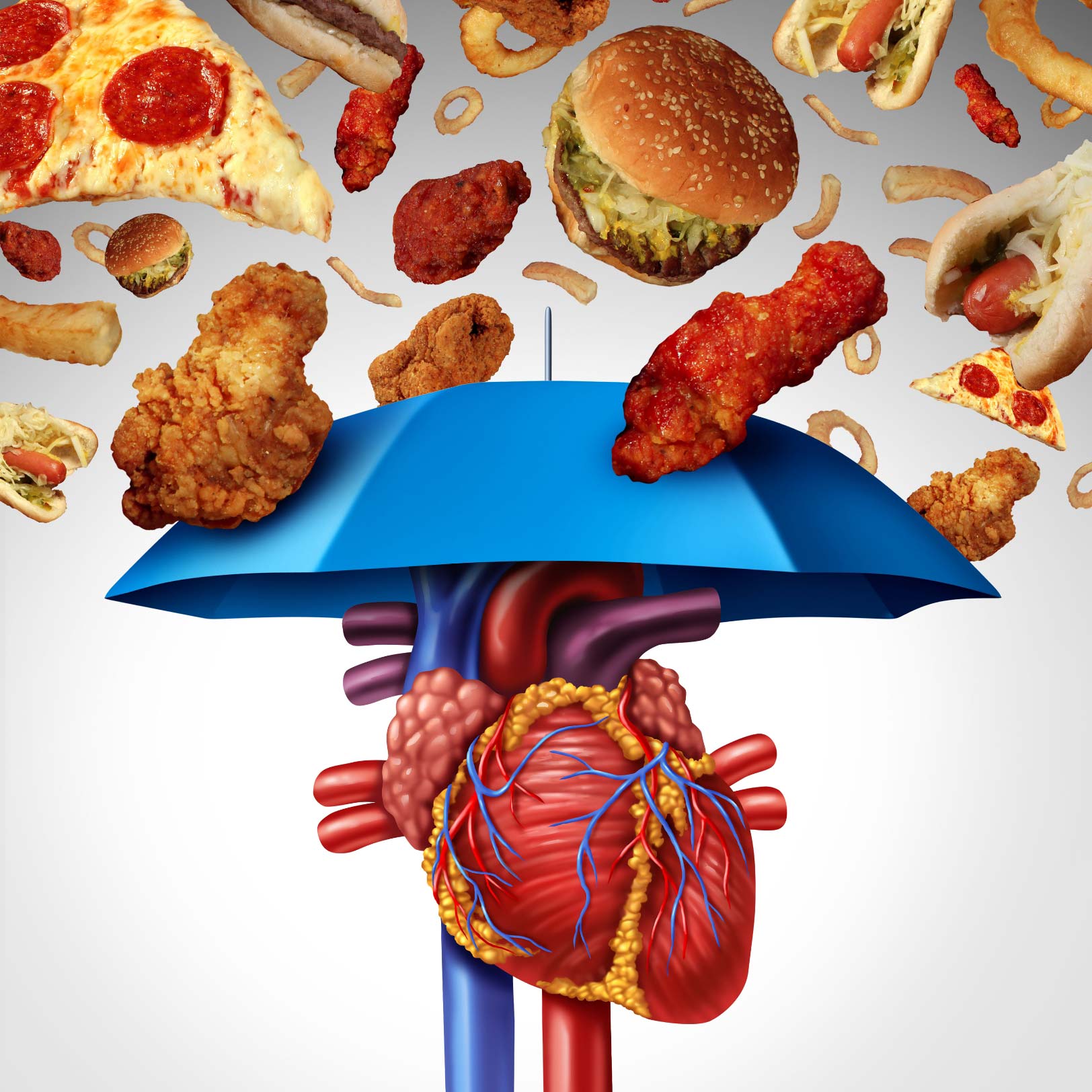8 อาหารบำรุงหัวใจ และหลอดเลือด เพื่อผู้สูงวัย ช่วยลดภาวะเสี่ยงหลอดเลือดตีบตันจากไขมัน โดยสารอาหารสำคัญ ได้แก่ กระเทียม EGCG ในชาเขียว และโคเอนไซม์คิวเท็น
โรคหัวใจและหลอดเลือด เกิดจาก?
โรคหัวใจและหลอดเลือดเป็นโรคที่มักจะเกิดขึ้นในผู้สูงอายุ เกิดจากการสะสมของตะกรันในหลอดเลือดแดง เมื่อหลอดเลือดอุดตัน ส่งผลให้เกิดภาวะเส้นเลือดตีบหรือตัน กล้ามเนื้อขาดเลือดไปเลี้ยง ทั้งหลอดเลือดหัวใจและสมอง จึงถือว่าเป็นโรคที่เป็นอันตรายต่อชีวิตได้
โรคหัวใจและหลอดเลือดมีเหตุปัจจัยหนึ่งมาจากพฤติกรรมการใช้ชีวิต โดยเฉพาะการกินอาหาร ดังนั้นการปรับรูปแบบการกิน และการใช้ชีวิตจึงมีความสำคัญ เพราะช่วยลดความเสี่ยงของการเกิดหัวใจและหลอดเลือดได้ โดยการเลือกกินอาหารที่มีส่วนช่วยในการบำรุงหัวใจและหลอดเลือด จะเป็นกุญแจสำคัญนำไปสู่การมีสุขภาพดีห่างไกลโรคร้าย
ระดับไขมันในเลือดเท่าไร เสี่ยงต่อการเกิดโรคหัวใจ
ปัจจัยเสี่ยงของโรคหัวใจและหลอดเลือด คือ ระดับไขมันในเลือด หากมีระดับไขมันในเลือดมาก ก็จะมีอัตราการเกิดโรคหัวใจมาก โดยปกติแล้วระดับไขมันในเลือดที่ร่างกายควรมี ดังนี้
| ปัจจัยเสี่ยงของโรคหัวใจและหลอดเลือด | ระดับไขมันในเลือด มิลลิกรัม/เดซิลิตร |
|---|---|
| คอเลสเตอรอล | ไม่เกิน 200 |
| ไขมัน LDL | น้อยกว่า 100 |
| ไขมัน HDL | ไม่เกิน 40 |
| ไตรกลีเซอไรด์ | ไม่เกิน 150 |
8 อาหารบำรุงหัวใจและหลอดเลือด
โรคหัวใจและหลอดเลือด เป็นโรคอันตรายที่เกิดขึ้นกับผู้ป่วยจำนวนมาก ทั้งนี้สาเหตุหนึ่งมาจากอาหารการกินที่ไขมันสูง อาจทำให้ระบบหัวใจ และหลอดเลือดอุดตัน ดังนั้นการปรับเปลี่ยนพฤติกรรมการกินเพียงเล็กๆ น้อยๆ อาจมีส่วนในการช่วยลดความเสี่ยงโรคหัวใจและหลอดเลือดได้
ผู้ที่มีความเสี่ยง หรือกังวลเรื่องหัวใจเป็นพิเศษ จึงควรเลือก 8 อาหารบำรุงหัวใจและหลอดเลือด ที่หาได้ง่าย รสชาติอร่อย มาบริโภคเป็นประจำ
1. กระเทียม
กระเทียม สมุนไพรที่มีติดครัวทุกบ้าน เป็นพืชล้มลุกที่มีหัวอยู่ใต้ดิน มักนิยมนำหัวกระเทียมมาประกอบอาหารหลากหลายชนิด นอกจากนั้นกระเทียมยังเป็นพืชสมุนไพรที่มีประโยชน์ทางยาด้วย เช่น ต้านการอักเสบจากเชื้อแบคทีเรีย และไวรัสบางชนิด ลดระดับคอเลสเตอรอลและไขมันชนิดไม่ดีต่อร่างกาย เป็นต้น สำหรับสารออกฤทธิ์สำคัญในกระเทียม คือ ไดซัลไฟด์ ที่ช่วยควบคุมระดับคอเลสเตอรอล และไขมันในเลือด โดยการทำลายคอเลสเตอรอลและไขมันที่เกาะผนังด้านในหลอดเลือด ช่วยให้เลือดไหลเวียนได้สะดวก ทำให้หัวใจมีสุขภาพดีแข็งแรง กระเทียมจึงเป็นสมุนไพรบำรุงหัวใจชนิดหนึ่งที่หาได้ง่ายในชีวิตประจำวัน1
2. ชาเขียว
ชาเขียวเป็นเครื่องดื่มที่ได้รับความนิยม จัดเป็นอาหารบำรุงหัวใจที่มีสรรพคุณในเรื่องการยับยั้งการออกซิไดซ์ของไขมัน LDL และคอเลสเตอรอล ในชาเขียวอุดมไปด้วยสารสำคัญที่เรียกว่า EGCG หรือ แคททิซิน (Catechin) ที่มีคุณสมบัติดูดซึมคอเลสเตอรอลจากอาหารเข้าสู่เลือด จึงช่วยให้คอลสเตอรอลรวมและ ไขมัน LDL ลดลง ป้องกันภาวะตีบตันของหลอดเลือด และลดความดันโลหิตได้
3. ปลาทะเลที่มีไขมันดี
อาหารที่บำรุงหัวใจอีกประเภทหนึ่ง คือ ปลาทะเลที่มีไขมันดี ส่วนใหญ่เป็นปลาประเภท ปลาซาร์ดีน ปลาทูน่า เมคเคอเรล และแซลมอน โดยเฉพาะปลาทูน่าและแซลมอน เป็นอาหารที่มีโอเมก้า 3 ในปริมาณสูง ซึ่งเป็นกรดไขมันที่ทำหน้าที่ในการลดระดับไตรกลีเซอร์ไรด์ ลดความดันโลหิต และการจับตัวของลิ่มเลือด จึงมีส่วนช่วยในการลดความเสี่ยงของโรคหัวใจและหลอดเลือดได้2
นอกจากนั้น ปลาทะเลยังเป็นอาหารบำรุงหัวใจที่อุดมไปด้วยสารอาหารสำคัญอย่าง โคเอนไซม์คิวเท็น ซึ่งช่วยทำให้กล้ามเนื้อหัวใจทำงานอย่างมีประสิทธิภาพ ลดความเสี่ยงของการเกิดภาวะหลอดเลือดแข็งตัว โดยการจำกัดปริมาณของไขมันที่สะสมบนผนังหลอดเลือด จึงมีส่วนช่วยในป้องกันการอุดตันของหลอดเลือดได้
4. พาร์สลีย์ และวอเตอร์เครส
พาร์สลีย์ และวอเตอร์เครส เป็นผักบำรุงหัวใจที่มีคุณประโยชน์มากมาย เนื่องจากพาร์สลีย์และวอเตอร์เครสเป็นผักใบเขียวที่มีสารฟลาโวนอยด์สูง อุดมไปด้วยวิตามินเค วิตามินเอ และเกลือแร่ต่างๆ ซึ่งจะช่วยทำให้หลอดเลือดแข็งแรง ขยายตัวดี เลือดมีปริมาณออกซิเจนที่เหมาะสม สามารถไหลเวียนไปยังหัวใจและส่วนอื่นๆ ได้สะดวก จึงลดความเสี่ยงของโรคหัวใจและหลอดเลือด3
5. แอปเปิล
แอปเปิลมีพรีไบโอติกที่ช่วยในการลดระดับคอเลสเตอรอลในเลือด พรีไบโอติกเป็นแหล่งอาหารของแบคทีเรียที่เป็นประโยชน์ในกระเพาะอาหาร ที่จะช่วยย่อยสลายคอเลสเตอรอล และยับยั้งการดูดซึมคอเลสเตอรอลผ่านผนังลำไส้ได้ ทั้งนี้พรีไบโอติกยังเสริมสร้างระบบภูมิคุ้มกันของร่างกายให้ทำงานได้ดีขึ้น ทำให้ลดความเสี่ยงของการเกิดโรคหัวใจและหลอดเลือดด้วย4
6. ถั่ว และธัญพืชชนิดต่างๆ
ถั่วและธัญพืชต่างๆ ก็เป็นหนึ่งในอาหารบำรุงหัวใจที่ดี ไม่ว่าจะเป็น อัลมอนด์ วอลนัท ข้าวโอ๊ต เมล็ดแฟลกซ์ และเมล็ดเชีย เป็นต้น สำหรับอาหารประเภทถั่วนั้น อุดมไปด้วยไฟเบอร์ที่ดีต่อหัวใจ เพราะมีสารอาหารที่สำคัญ คือ วิตามินเค ซึ่งมีส่วนช่วยในการลดระดับคอเลสเตอรอลในร่างกาย ซึ่งแม้ว่าในอดีตจะไม่นิยมกินถั่วเพราะเชื่อว่ามีไขมันสูง ทว่าจากการศึกษาในปัจจุบันพบว่าถั่วและธัญพืชต่างๆ อย่างวอลนัท เมล็ดแฟลกซ์ และเมล็ดเชีย มีปริมาณโอเมก้า 3 จากพืชในปริมาณสูง ซึ่งมีส่วนช่วยในเรื่องการต้านอาการอักเสบ และช่วยบำรุงระบบไหลเวียนของเลือดอีกด้วย5
7. ผลไม้ตระกูลเบอร์รี
ผลไม้ตระกูลเบอรรี เป็นผลไม้บำรุงหัวใจที่ทุกคนควรกิน เช่น สตรอว์เบอร์รี บลูเบอรี แบล็คเคอร์เรนท์ แครนเบอรี มัลเบอร์รี ราสพ์เบอรี เป็นต้น ผลไม้ตระกูลเบอร์รีเหล่านี้มีสารแอนโทไซยานิน และสารฟลาโวนอยด์ ซึ่งมีคุณสมบัติในการต้านอนุมูลอิสระ และยังช่วยลดความดันโลหิตและขยายหลอดเลือดหัวใจได้ดี จึงช่วยลดความเสี่ยงที่เกี่ยวกับโรคหัวใจและหลอดเลือดได้2
8. ดาร์กช็อกโกแลต
ดาร์กช็อกโกแลต ที่มีส่วนผสมของโกโก้อย่างน้อย 60-70% ถือเป็นอาหารบำรุงหัวใจที่ดี ในดาร์กช็อกโกแลตประกอบไปด้วย สารฟลาโวนอยด์ ชนิดที่เรียกว่า โพลีฟีนอล ซึ่งเป็นสารต้านอนูมูลอิสระที่มีส่วนช่วยในเรื่องความดันโลหิต และยังช่วยลดปัจจัยที่ทำให้เลือดแข็งตัวอีกด้วย จึงส่งผลให้สามารถลดความเสี่ยงของโรคหัวใจและหลอดเลือดได้2
อาหารที่ควรหลีกเลี่ยง ลดความเสี่ยงโรคหัวใจ

มีอาหารหลายประเภทที่ควรหลีกเลี่ยงหากไม่ต้องการเสี่ยงกับโรคหัวใจและหลอดเลือด ซึ่งหากในชีวิตประจำวันสามารถหลีกเลี่ยงหรืองดอาหารเหล่านี้ได้ จะช่วยป้องกันโรคร้าย และยังทำให้สุขภาพดีขึ้นด้วย โดยอาหารที่ควรหลีกเลี่ยง ลดความเสี่ยงโรคหัวใจ ได้แก่
1. อาหารที่มีไขมันอิ่มตัวสูง
อาหารที่มีไขมันอิ่มตัวสูง เป็นไขมันที่ได้จากสัตว์ ถือเป็นไขมันที่ไม่ดีต่อสุขภาพเป็นอย่างยิ่ง เช่น เนย ชีส เนื้อติดมัน เป็นต้น ควรพยายามลดการกินอาหารเหล่านี้ สำหรับปริมาณที่เหมาะสมคือ ไม่ควรเกิน 6% ของปริมาณแคลอรีที่ได้รับต่อวัน (เช่น หากร่างกายรับ 2,000 แคลอรีต่อวัน ปริมาณไขมันอิ่มตัว ไม่ควรเกิน 11-13 กรัม) เพราะอาหารที่มีไขมันอิ่มตัวสูงนั้นจะทำให้เกิดการสะสมของไขมันในหลอดเลือด นำไปสู่ภาวะหลอดเลือดอุดตัน เป็นปัจจัยเสี่ยงสำคัญของโรคหัวใจและหลอดเลือด รวมไปถึงอาการอันตรายอื่นๆ ด้วย7
2. อาหารที่มีน้ำตาลสูง
อาหารที่มีน้ำตาลสูง ทั้งอาหารคาว อาหารหวาน และเครื่องดื่ม เช่น ขนมหวาน เค้ก เครื่องดื่มชา น้ำอัดลมต่างๆ ล้วนเป็นสาเหตุของโรคหัวใจและหลอดเลือดทั้งสิ้น การกินน้ำตาลมาก จะทำให้ระดับน้ำตาลในเลือดสูง ส่งผลให้หลอดเลือดเสื่อมสภาพ เนื่องจากน้ำตาลทำให้เกิดคราบตะกรันสะสมบริเวณหลอดเลือด จะทำให้หลอดเลือดตีบตัน การไหลเวียนเลือดทำได้ไม่ดี และกลายเป็นภาวะหลอดเลือดแข็งตัวในที่สุด กลายเป็นปัญหาโรคร้ายที่เกี่ยวข้องกับระบบหัวใจและหลอดเลือด8
3. อาหารที่มีโซเดียมสูง
อาหารที่มีโซเดียมสูง จะเป็นอาหารประเภทที่มีรสเค็ม เช่น อาหารกระป๋อง อาหารสำเร็จรูป เป็นต้น เนื่องจากการกินโซเดียมปริมาณมากจะนำไปสู่ภาวะความดันโลหิตสูงได้ ซึ่งภาวะความดันโลหิตสูงจะส่งผลโดยตรงต่อการทำงานของหัวใจ ส่งผลให้เกิดโรคกล้ามเนื้อหัวใจขาดเลือด และโรคหลอดเลือดสมอง จึงควรจำกัดปริมาณการกินอาหารที่มีโซเดียมสูง นอกจากนี้ ปริมาณการกินโซเดียมในผู้ใหญ่ทั่วไปไม่ควรเกิน 2,300 มิลลิกรัมต่อวัน หากร่างกายได้รับโซเดียมมากเกินไป จะทำให้เกิดการคั่งของเกลือและน้ำในอวัยวะต่างๆ ส่งผลอันตรายต่อหัวใจ8
4. เครื่องดื่มแอลกอฮอล์
เครื่องดื่มแอลกอฮอล์ ไม่ว่าจะเป็น เหล้า เบียร์ และไวน์ ล้วนส่งผลต่อสุขภาพ การดื่มแอลกอฮอล์จะทำให้ร่างกายสะสมแคลอรีที่อาจเป็นเหตุให้เกิดภาวะน้ำหนักตัวเพิ่มมากขึ้น อีกทั้งยังเป็นตัวกระตุ้นให้ระดับไตรกรีเซอร์ไรด์และความดันในเลือดสูงขึ้น ซึ่งส่งผลเสียต่อหัวใจ อาจก่อให้เกิดภาวะหัวใจหดเกร็ง และโรคอื่นๆ ที่เกี่ยวข้อง8
ภาวะแทรกซ้อนจากโรคหัวใจและหลอดเลือด
ผู้สูงอายุมักเผชิญกับโรคหัวใจ เนื่องด้วยปัจจัยเสี่ยงต่างๆ ไม่ว่าจะเป็น พฤติกรรมการใช้ชีวิต อาหารการกิน อายุ เพศ ตลอดจนประวัติสุขภาพของคนในครอบครัว นอกจากนั้น โรคหัวใจมีภาวะแทรกซ้อนที่อาจเกิดได้อีกด้วย ซึ่งเป็นภาวะที่อันตรายต่อร่างกายมาก ได้แก่9
- ผู้สูงอายุมักเผชิญกับโรคหัวใจ เนื่องด้วยปัจจัยเสี่ยงต่างๆ ไม่ว่าจะเป็น พฤติกรรมการใช้ชีวิต อาหารการกิน อายุ เพศ ตลอดจนประวัติสุขภาพของคนในครอบครัว นอกจากนั้น โรคหัวใจมีภาวะแทรกซ้อนที่อาจเกิดได้อีกด้วย ซึ่งเป็นภาวะที่อันตรายต่อร่างกายมาก ได้แก่9
- โรคหลอดเลือดสมอง เกิดในกรณีที่หลอดเลือดแดงที่จะนำเลือดไปเลี้ยงสมองเกิดการปิดกั้นหรือแคบลง ทำให้สมองขาดเลือด
- กล้ามเนื้อหัวใจขาดเลือดเฉียบพลัน เกิดจากการตีบตันของหลอดเลือดแดง อันเนื่องมาจากลิ่มเลือดปิดกั้นการไหลเวียนของเลือดที่ไปเลี้ยงหัวใจ ซึ่งอันตรายถึงขั้นเสียชีวิตได้
- ภาวะหัวใจหยุดเต้นกะทันหัน เกิดจากภาวะที่หัวใจเต้นผิดจังหวะ ซึ่งเป็นภาวะฉุกเฉิน และเป็นอันตรายถึงชีวิตได้
สรุป
โรคหัวใจและหลอดเลือดเป็นภาวะที่อันตราย และถึงขั้นเสียชีวิตได้ เพื่อลดความเสี่ยงของโรค ควรปรับเปลี่ยนพฤติกรรมที่ก่อให้เกิดปัจจัยเสี่ยงโรคหัวใจและโรคอื่นๆ ที่เป็นภาวะแทรกซ้อนอันตราย โดยเริ่มจากการปรับเปลี่ยนพฤติกรรมการกินอาหาร หันมากินอาหารบำรุงหัวใจ หลีกเลี่ยงหรืองดอาหารที่จะก่อให้เกิดผลเสียต่อสุขภาพ เพื่อเป็นการป้องกันไม่ให้เกิดโรคร้ายในอนาคต

